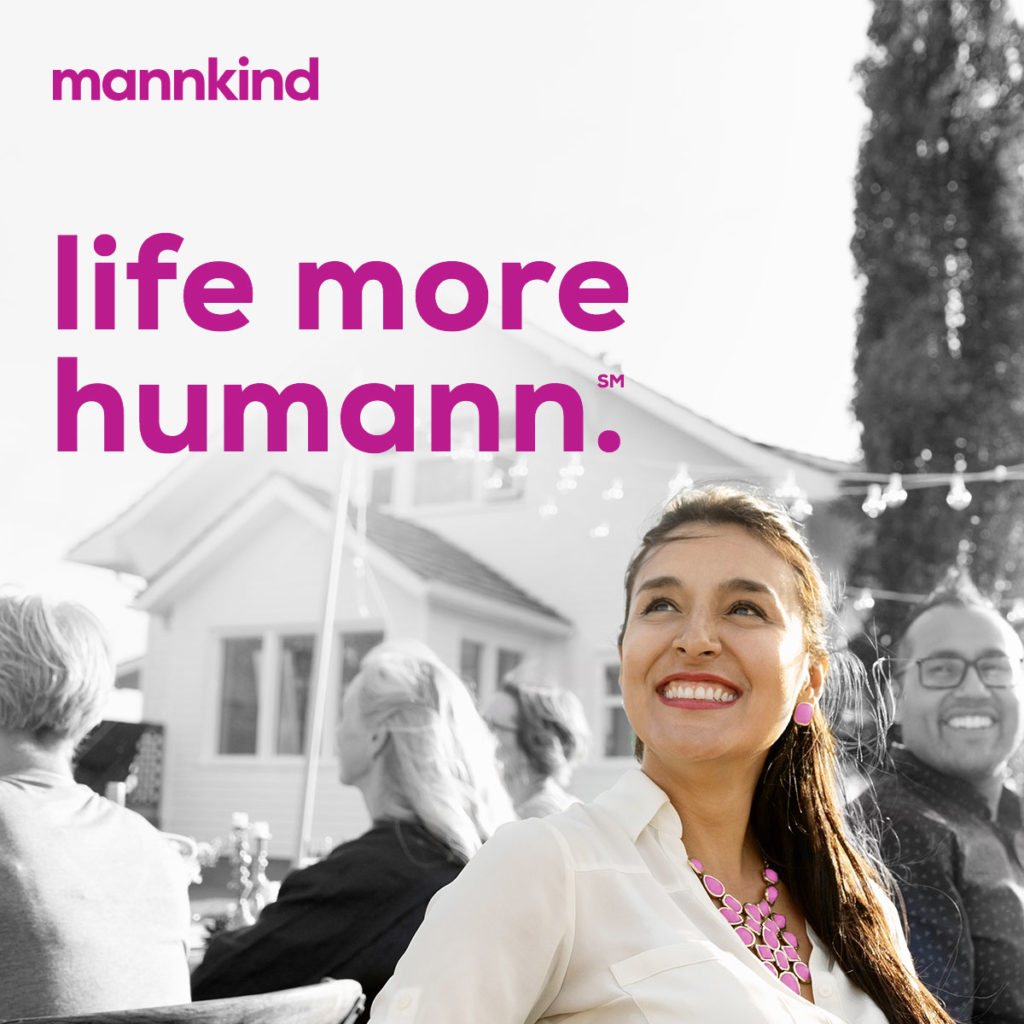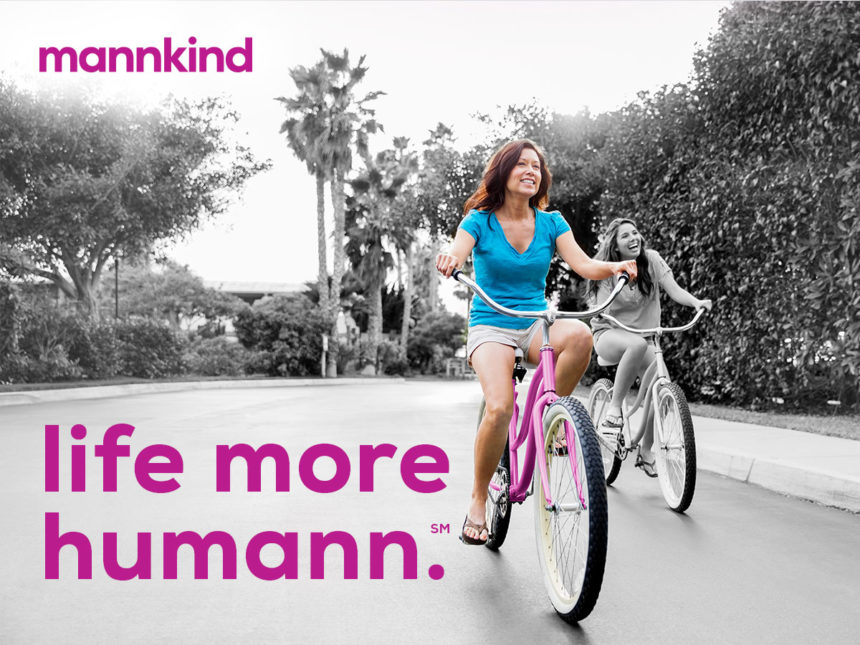Toward the end of his company’s first extensive rebranding push in two decades, MannKind CEO Michael Castagna braced himself for disappointment. The exercise, which had commenced in the summer of 2019, included a re-evaluation of the company’s mission and values statements and an overhaul of its brand voice. When the visual branding piece got underway, Castagna sensed he was about to be outvoted.
“We used to have a little DNA helix logo that I loved, and I had a hard time letting go of it because I’m a pharmacist,” he says. “Once something like this goes away, you know we’ll never get it back.” He nonetheless bowed to the wishes of the MannKind team — some 25% of the company’s people participated in focus groups around the rebranding — and seems at peace with the decision, enthusing about the “clean, sleek-looking logo that’s really bold.”
Castagna relates this story, as well as others about the company’s recent fortunes, on the Thursday morning of what had been dubbed MannKind Brand Launch Week. Monday found him at the company’s Westlake Village, California, home base, which had been prepped over the weekend with new lobby signage and personalized desk drops. On Tuesday and Wednesday, he oversaw the distribution of the new brand toolkit and led a call with MannKind’s field staff, then jumped on the red-eye for a slate of unveiling activities at the company’s Danbury, Connecticut, manufacturing plant (“employee giveaways — tote and jacket”).
Upon landing in Newark in the early morning hours, Castagna hopped in a rental car and drove the two hours to Danbury, at which point he presided over a 90-minute employee town hall. The next day, the activity slate called for continued social media rollout and, presumably, continued enthusiastic brand promotion.
If the week-long blitz exhausted Castagna or tested his patience, you’d be hard-pressed to tell by his energetic, upbeat demeanor during a nearly hour-long conversation. He seems to accept that, after years of disappointing results, MannKind has something to prove — and he clearly relishes the opportunity to advance the new narrative.
“We had a founder who spent $1 billion of his own money and 20 years to build the new insulin,” Castagna says, referring to MannKind’s signature product and delivery device Afrezza, still the only inhaled insulin on the market in the U.S. “I joined the company in 2016 at the time when there was literally $17 million in the bank and $7 million in sales the previous year. We were losing $100 million a year. A lot of people thought we were going to disappear.”
Even amid that perception, Castagna was eager to join MannKind as chief commercial officer, alongside former CFO turned CEO Michael Pfeffer. Castagna started his career as a pharmacist, working for CVS prior to the chain’s growth spurt, but quickly realized the job wasn’t an ideal fit. “I wasn’t cut out for the medical side of the business,” he says.
Roles at Bristol-Myers Squibb (on an HIV drug), Serono (fertility), Sandoz (biosimilars) and Amgen (oncology) eventually followed; Castagna went back to school and, in 2005, received an MBA from The Wharton School of the University of Pennsylvania. When he returned to BMS, it was for a reclamation project of sorts: The company’s rheumatoid arthritis drug Orencia hadn’t exactly charged out of the gates, and Castagna joined the team tasked with reversing its fortunes.
It was at that point Castagna realized not only that he had something of a gift for turnarounds, but he also was acquiring a reputation as one of the industry’s turnaround aces. He leaned into it.
“Most drugs that don’t launch well get pushed to the side and buried, even though they might be good drugs,” he explains. “In many cases it’s because the plans weren’t laid right. My thinking was always, ‘I’m going to try and understand what differentiates that product. Is it a pricing play? A packaging play? A device play?’”

MannKind has rebranded for the first time in 20 years, overhauling its logo and dropping the helix design for a “clean, sleek-looking logo that’s really bold.”
Castagna believes industry marketers avoid making such distinctions prior to launch, preferring instead to fall back on safer, time-tested approaches. “The hard part is that people try to wait for customers to tell them what they want,” he continues. “I always think back to Steve Jobs and the iPhone. If he’d done market research, it’d have been, ‘I’m going to sell you a $700 device that’s glass’ and nobody would’ve wanted it. But he made it such a good user experience that people can’t live without it.”
Castagna extends the analogy to pharma, and Afrezza in particular. “I realized that patients figured out how to use the drug before the company figured it out,” he says. “I felt that you could get these phenomenal patient stories and share them with the physician to close that knowledge gap.”
That, in part, is why he has such a deep, abiding belief in Afrezza, despite its tortured lineage. After it got FDA approval in 2014, MannKind inked a deal with Sanofi to manufacture the product and market it alongside the drugmaker’s diabetes drug Lantus. Less than two years later, amid tepid sales, Sanofi ended the deal; MannKind relaunched the drug in mid-2016. In Q3 2019, Afrezza net revenue reached $6.4 million — up 46% over Q3 2018, but still quite a way from blockbuster territory.
It should be noted that Castagna is not the first CEO to attempt to breathe life into Afrezza. Former chief execs Hakan Edstrom, Duane DeDisto and Pfeffer had their own ideas that ultimately didn’t work.
But Castagna still believes the best is yet to come. “What you saw on Afrezza is people taking to Instagram and Twitter and saying, ‘I’ve never had such great health outcomes,’” he says. “I’ve never seen a drug where people say, ‘I’d rather cash out my life savings than live without it.’”
This high degree of confidence in Afrezza clearly informs the brand revamp. Last August, MannKind concluded a recapitalization effort, placing it on firmer financial ground than it had been in some time. “We had debt holders who were senior-secured and could’ve been not very nice,” Castagna says. “We worked our way through that with them.”
The updated branding, not surprisingly, focuses on what’s ahead. Per a MannKind Rebrand 2020 deck produced in early February, motivations for the effort include addressing “low brand awareness and confusion between corporate and product brands.” The stated goals, on the other hand, include “increase brand awareness and attract top talent.” It cites 23andMe, Vertex, Apple and Starbucks as “brand inspiration” and lists “friendly,” “entrepreneurial,” “bold” and “cutting-edge/innovative” as brand personality attributes.
“It begins with a company that believes… to care is to be humann,” reads one sentence in the brand story document.
“We know that the company will be here for the long run and we can control our own destiny,” Castagna says, crediting director, corporate communications Naomi Bandison-Johnson as the driving force behind the new brand. MannKind has not hired a replacement for chief marketing officer Garrett Ingram, who left the company in June.
We’ll be one of the mainstays. We did an assessment and identified three to five new opportunities we think we can win in and start to move forward. We’re just getting started.
Michael Castagna, MannKind
The road ahead for MannKind is likely to present its share of challenges. Never a Wall Street darling, the company has taken heat for the amount it spent marketing Afrezza. Also, while Castagna talks with great pride about MannKind’s pipeline prospects, the company’s most recent high-profile success has been hitting the second of four developmental milestones for Treprostinil Technosphere, a pulmonary arterial hypertension product being developed under a licensing agreement with United Therapeutics.
That said, Castagna is enthused by what he has heard in recent months, especially in the wake of his appearance at the JP Morgan Healthcare Conference in January. “There were a lot of positive comments from analysts and from Wall Street partners, really saying, ‘You guys survived, you’re growing double-digits, you’ve got a pipeline move,’” he says.
Along those lines, Castagna points to two high-profile additions in recent years — former Lilly Diabetes research physician and VP of global medical affairs Dr. David Kendall, now MannKind’s chief medical officer, and former Amgen SVP and chief human resources officer Stuart Tross, now MannKind’s chief people officer — as evidence the company was able to “get some great people to join at a time when the company didn’t have a lot of money, maybe didn’t have the best reputation. Smart people want to work with smart people.”
Look for Afrezza to go global, likely in partnership with another organization or organizations. Similarly, expect MannKind to double down on endocrinology, even as other companies seek to exit the highly competitive space.
“We’ll be one of the mainstays,” Castagna predicts. “We did a landscape assessment and identified three to five new opportunities we think we can win in and start to move forward. We’re just getting started.”
From the March 01, 2020 Issue of MM+M - Medical Marketing and Media







